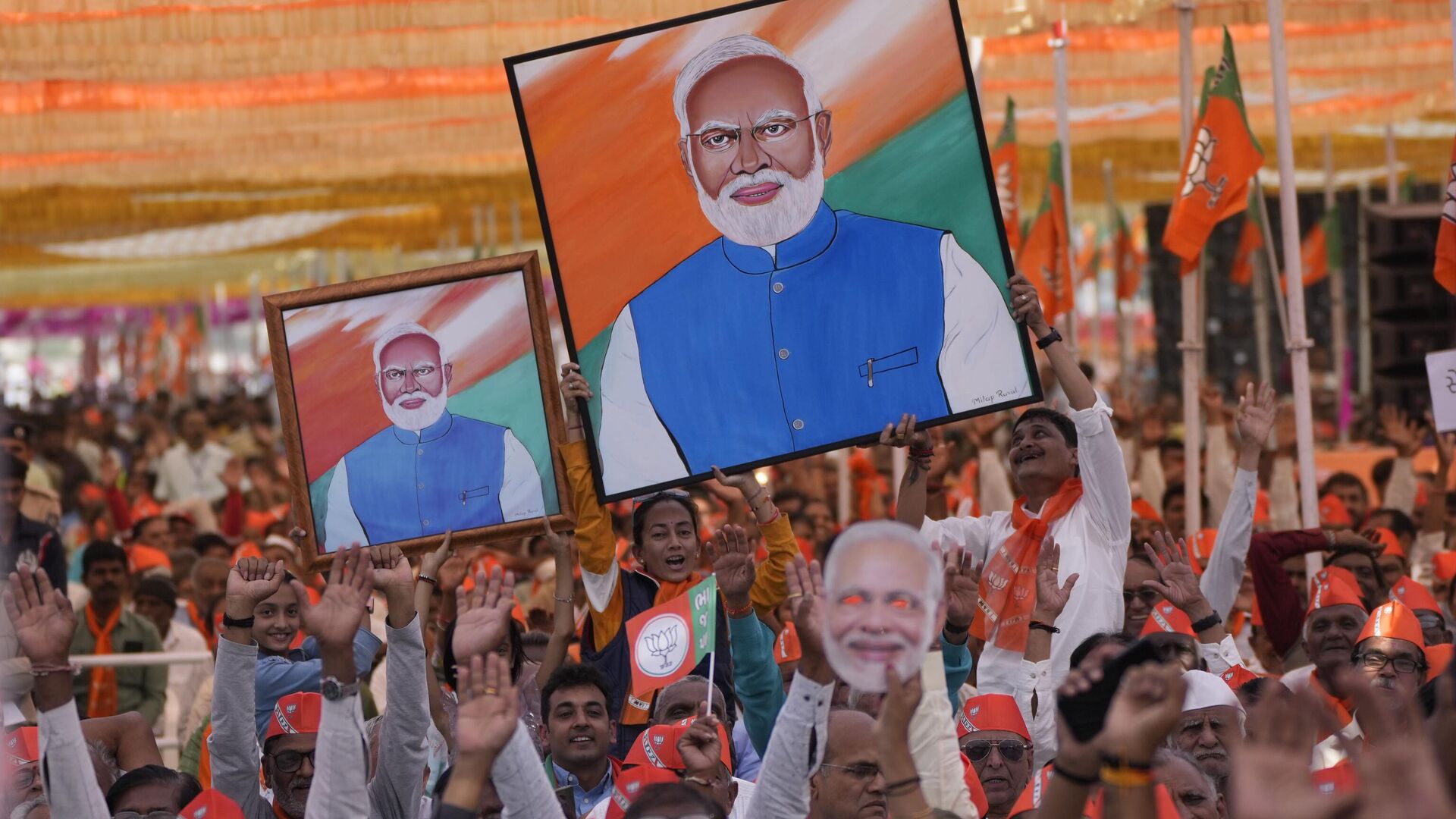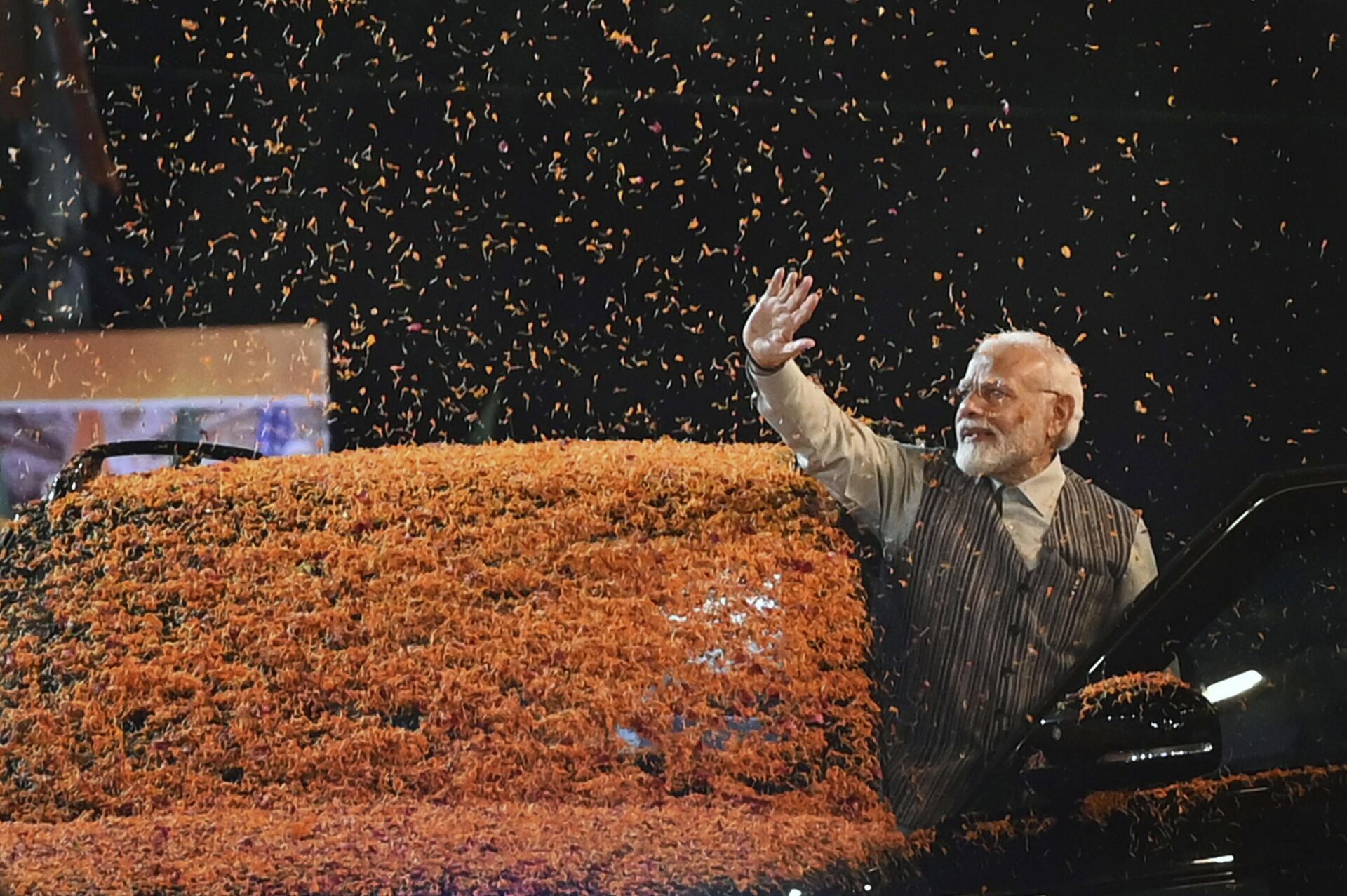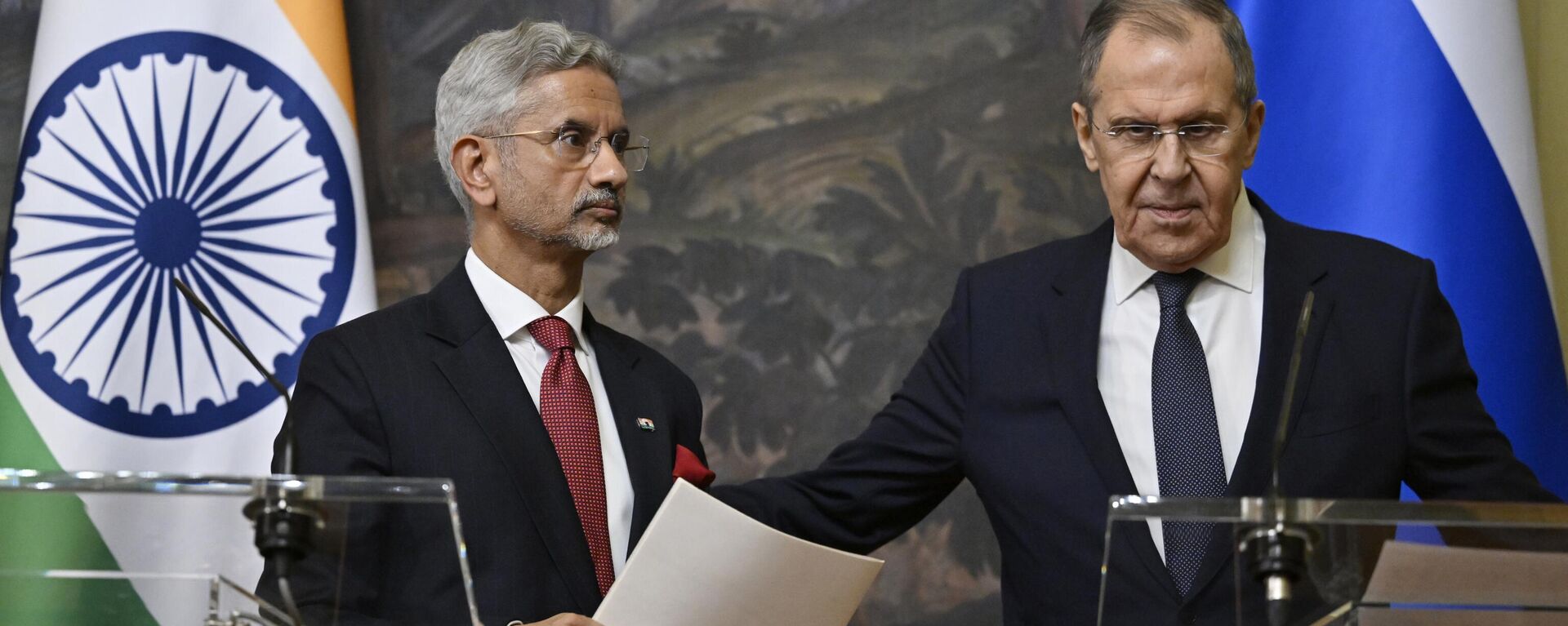https://sputniknews.in/20240519/indias-middle-class-pivotal-to-realise-modis-viksit-bharat-goal-by-2047-7401969.html
India's Middle-Class 'Pivotal' to Realise Modi's 'Viksit Bharat' Goal by 2047
India's Middle-Class 'Pivotal' to Realise Modi's 'Viksit Bharat' Goal by 2047
Sputnik India
India's middle-class population will play a "pivotal role" in the country's vision to transition from a developing to a developed nation (Viksit Bharat) by 2047, a leading Indian statistician has told Sputnik India.
2024-05-19T15:51+0530
2024-05-19T15:51+0530
2024-05-19T15:51+0530
business & economy
india
us
europe
narendra modi
bharatiya janata party (bjp)
developing nations
economic crisis
economic challenges
economics
https://cdn1.img.sputniknews.in/img/07e8/01/19/6339260_0:160:3072:1888_1920x0_80_0_0_b095591d8ff502b0bd37616b055f0557.jpg
India's middle-class population will play a "pivotal role" in the country's vision to transition from a developing to a developed nation (Viksit Bharat) by 2047, the Managing Director and CEO of Indian think tank People Research on India's Consumer Economy (PRICE), Dr Rajesh Shukla has told Sputnik India.He has forecasted that India's middle-class population would surge to 165 million households by 2031 from 91 million in 2020-21, according to ICE 360 (India’s Consumer Economy) survey conducted by Shukla's think-tank.Indian households having an annual income between $6,000-$30,000 have been bracketed in the middle-class category, it said.The survey estimated that the middle-class would constitute around 61 percent of India's overall population by 2047 if the nation continued to grow annually at an average of six to seven percent. India is projected to become the world's third-largest economy in coming years, by when it would trail only US and China in Gross Domestic Product (GDP).In 2020-21, the middle-class accounted for nearly 31 percent of the country's billion-strong population.What are the Major Challenges Facing Indian Middle-Class?Shukla cautioned that income inequality and job security were major "challenges" facing the middle-class.According to various reports, around 2.6 percent of country's national income went to top 1 percent rich individuals in 2022-23, the highest since 1922.Further, studies have suggested that wealthiest one percent of Indians controlled 40 percent of the wealth in 2022-23, which is the highest level since 1961.In terms of unemployment, Periodic Labour Force Survey (PLFS) findings by the Indian government released in March showed that unemployment rate (UR) decreased to 3.1 percent in 2023 as compared to 3.6 percent in 2022.However, a poll of 26 economists conducted by Reuters in April predicted that providing jobs for India's large youth population would be the most pressing economic challenge for Prime Minister Modi in his third term, should he win the ongoing Lok Sabha election.Shukla noted that savings rate had improved to 22 percent in 2022-23 from around 17 percent in 2020-21. He estimated that it would further rise to 28 percent by 2031.Shukla emphasised that it was absolutely critical that Indian policy-makers focus on "inclusive economic policies", bolster education and healthcare systems, create robust infrastructure development to "support and empower the middle class".Do India's Current Policies Favour the Middle-Class?Around 250 million Indians have been lifted from multi-dimensional poverty since 2014 as a direct result of welfare schemes run by Prime Minister Modi's government, according to official records.India is running the biggest free food grain distribution scheme in the world (PM Garib Kalyan Anna Yojana), providing food to almost 800 million people.Over 40 million free houses have been sanctioned for the poor, coupled with other schemes providing electrification and guarantee of potable water to every Indian household. Additionally, direct cash transfers and subsidies to farmers, women and other vulnerable strata of Indian society have been hugely popular among economically backward Indians.On the other hand, household savings data and several other economic indicators point towards a growing pressure on middle-class households.The expert stressed that a "balanced and inclusive approach" was crucial to comprehensively support the middle class's pivotal role in India's economic growth.
https://sputniknews.in/20240515/jaishankar-explains-russias-important-role-in-indias-viksit-bharat-goal-7368474.html
india
us
europe
Sputnik India
feedback.hindi@sputniknews.com
+74956456601
MIA „Rossiya Segodnya“
2024
Dhairya Maheshwari
https://cdn1.img.sputniknews.in/img/07e6/0c/13/138962_0:0:641:640_100x100_80_0_0_2cb44360dbcdf6d84bf4b299cd045917.jpg
Dhairya Maheshwari
https://cdn1.img.sputniknews.in/img/07e6/0c/13/138962_0:0:641:640_100x100_80_0_0_2cb44360dbcdf6d84bf4b299cd045917.jpg
News
en_IN
Sputnik India
feedback.hindi@sputniknews.com
+74956456601
MIA „Rossiya Segodnya“
Sputnik India
feedback.hindi@sputniknews.com
+74956456601
MIA „Rossiya Segodnya“
Dhairya Maheshwari
https://cdn1.img.sputniknews.in/img/07e6/0c/13/138962_0:0:641:640_100x100_80_0_0_2cb44360dbcdf6d84bf4b299cd045917.jpg
middle class population, middle class population in india, taxpayers in india, income tax in india, poverty in india, viksit bharat, modi news, bjp news, foreign investments in india, fdi in india, consumer spending in india, unemployment in india, inflation in india, social security schemes, india gdp growth
middle class population, middle class population in india, taxpayers in india, income tax in india, poverty in india, viksit bharat, modi news, bjp news, foreign investments in india, fdi in india, consumer spending in india, unemployment in india, inflation in india, social security schemes, india gdp growth
India's Middle-Class 'Pivotal' to Realise Modi's 'Viksit Bharat' Goal by 2047
India's middle-class, comprising over a third of the population, are the main taxpayers and viewed as the main drivers of country's economic growth. India's middle-class is expected to surge to over a billion by 2047, more than entire populations of US and Europe.
India's middle-class population will play a "pivotal role" in the country's vision to transition from a developing to a developed nation (Viksit Bharat) by 2047, the Managing Director and CEO of Indian think tank People Research on India's Consumer Economy (PRICE), Dr Rajesh Shukla has told Sputnik India.
He has forecasted that India's middle-class population would surge to 165 million households by 2031 from 91 million in 2020-21, according to ICE 360 (India’s Consumer Economy) survey conducted by Shukla's think-tank.
Indian households having an annual income between $6,000-$30,000 have been bracketed in the middle-class category, it said.
The survey estimated that the middle-class would constitute
around 61 percent of India's overall population by 2047 if the nation continued to grow annually at an average of six to seven percent. India is projected to become the
world's third-largest economy in coming years, by when it would trail only US and China in Gross Domestic Product (GDP).
In 2020-21, the middle-class accounted for nearly 31 percent of the country's billion-strong population.
Shukla explained that middle-class was one of the main drivers of domestic demand through consumption, as well as a major factor fuelling entrepreneurship, bolstering national savings and attracting foreign investments.
"Additionally, the importance of education and skill development within the middle class is emphasized, along with their influence on social cohesion and political engagement," the think-tanker said.
What are the Major Challenges Facing Indian Middle-Class?
Shukla cautioned that income inequality and job security were major "challenges" facing the middle-class.
According to various reports, around 2.6 percent of country's national income went to top 1 percent rich individuals in 2022-23, the highest since 1922.
Further, studies have suggested that wealthiest one percent of Indians controlled 40 percent of the wealth in 2022-23, which is the highest level since 1961.
In terms of unemployment, Periodic Labour Force Survey (PLFS) findings by the Indian government released in March showed that unemployment rate (UR) decreased to 3.1 percent in 2023 as compared to 3.6 percent in 2022.
However, a poll of 26 economists conducted by Reuters in April predicted that
providing jobs for India's large youth population would be the most pressing economic challenge for Prime Minister Modi in his third term, should he win the ongoing Lok Sabha election.
Shukla also described lower savings of Indian households as another major challenge facing the middle-class, and in effect the prospects of economic growth.
Shukla noted that savings rate had improved to 22 percent in 2022-23 from around 17 percent in 2020-21. He estimated that it would further rise to 28 percent by 2031.
"The implications of slow savings recovery are significant: it affects economic growth by reducing investment capital, increases household financial vulnerability, and impacts social stability by exacerbating income inequality. Policymakers should be concerned and focus on continued support measures, structural reforms, and financial education to accelerate savings recovery, ensuring long-term economic stability and inclusive growth," reckoned Shukla.
Shukla emphasised that it was absolutely critical that Indian policy-makers focus on "inclusive economic policies", bolster education and healthcare systems, create robust infrastructure development to "support and empower the middle class".
Do India's Current Policies Favour the Middle-Class?
Around
250 million Indians have been lifted from multi-dimensional poverty since 2014 as a direct result of welfare schemes run by Prime Minister Modi's government, according to official records.
India is running the biggest free food grain distribution scheme in the world (PM Garib Kalyan Anna Yojana), providing food to almost 800 million people.
Over 40 million free houses have been sanctioned for the poor, coupled with other schemes providing electrification and guarantee of potable water to every Indian household. Additionally, direct cash transfers and subsidies to farmers, women and other vulnerable strata of Indian society have been hugely popular among economically backward Indians.
On the other hand, household savings data and several other economic indicators point towards a growing pressure on middle-class households.
"While the perception that Indian government policies primarily benefit the poor holds some truth, they also offer opportunities for growth for the rich and middle class," Shukla explained.
The expert stressed that a "balanced and inclusive approach" was crucial to comprehensively support the middle class's pivotal role in India's economic growth.
"Subsidies and tax cuts target various groups, with the middle class benefiting indirectly through tax relief, housing initiatives, and education incentives. Affirmative policy initiatives, such as augmenting tax relief, expanding public services, skill development, and establishing adequate social security, are crucial to shield middle-class individuals from poverty during unforeseen circumstances," concluded Shukla.




